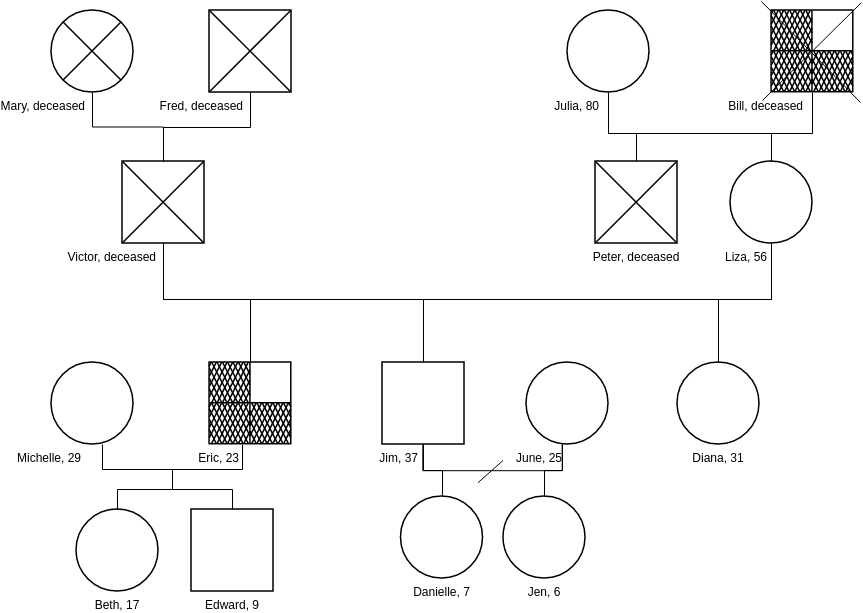
Starting with the oldest generation, you can represent your family members using the genogram symbols in the EdrawMax Symbol Library. Step 3: Draw the Members of the Family in Each Generation
Genogram software plus#
Open EdrawMax, navigate to New → Science and Education → Genogram, then choose a pre-made genogram example or the plus icon to open a blank drawing page. There are two methods of creating a genogram: hand-drawing and using easy genogram software.Ī digital genogram is much more convenient for storing and future editing. You may interview some family members for family stories to fill in missing information and complicated ties. Next, look at a family that meets your demand generations to gather all the names, birthdates, and fundamental relations. First, decide how many generations you wish to display on your genogram.
Genogram software how to#
The following instruction is about how to make professional genograms with our Genogram software - EdrawMax.Ĭollecting information on a family should be the start of your creation as background work. This genogram uses family relationship symbols to illustrate whether the couple is engaged, married, separated, divorced, and common-law. The difference is family relationship genogram conveys more data than the family tree, thus making it more complicated. For example, by using one of these symbols, you can tell whether a couple is in harmony, in love, in conflict, etc.Ī family tree and a family relationship genogram are two different things -so, keep that in mind. Unlike family relationship symbols, emotional relationship symbols focus on describing the type of emotional bond between two people. The Genogram symbol carries the necessary information of a person: gender, birth, age, immigration, sexual orientation and pregnancy status, etc. After all, it is about knowing what kind of information you want to learn from that genogram.Ī genogram is composed of various genogram symbols, which have comprehensive meanings in many aspects such as health status, family relations, emotional relations, and medical problems. To do this, you can talk to family members, search through family books, documents, and the internet (if ideal). This is especially aimed at understanding what you are looking for by looking at your own history. Once you have decided on the purpose, start writing down what you know already. Furthermore, you should develop a set of questions to ask yourself and your relatives. This is simply understanding what you are looking for, and you can do this by deciding on how many generations you need to represent in your genogram. What is the reason for creating a genogram? Always start by asking yourself this question because by knowing the purpose, you then know the next step. Therefore, here are what to do before creating a genogram.ġ)ĝecide your purpose of making a genogram These things are key factors as well as core builders of any professional genogram. The fact is, you can’t just go ahead and create a genogram without first doing or knowing certain things. Part 2: What to Do before Creating a Genogram We are analyzing an individual family's hereditary patterns and psychological factors to determine the medical history and what to do.ī) It can be a behavioral research study tool.Ĭ) We are helping mental health professions during counseling by gaining insights into what influences individuals’ families.ĭ) It helps to know more about patience abuse.Į) It helps in finding the ideal therapy for an individual. Genogram comes with several benefits, which include:Ī) Risk assessments. In the genogram example below, the genogram could explain Michael's close friendship with Ann, Paul's hostile against Magan, Max's conflictual relationship with Vivian, Edison, and Sara's harmony. Namely, a genogram goes deeper into revealing family information among all individuals. Unlike a traditional family tree, a genogram allows the user to visualize hereditary patterns and psychological factors that punctuate relationships. It is also named a McGoldrick–Gerson study, a Lapidus schematic, or a family diagram. Wikipedia defines a genogram as a pictorial display of a person's family relationships and medical history.

In simple terms, they help understand an individual's family relationships by visualizing patterns and psychological factors affecting them. This is because they help create an interactive picture of a person’s family relationships and history, which is essential in the medical field.

So, when it comes to studying or tracking a family history, a genogram is an ideal representation diagram to use. Notably, this growth in popularity has been realized majorly in the medical field. First developed in the 1980s by Monica McGoldrick and Randy Gerson in family therapy and clinical psychology settings, genogram has since gained more popularity.


 0 kommentar(er)
0 kommentar(er)
